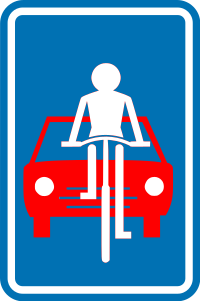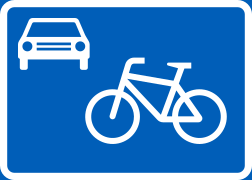Key:cyclestreet
| Description |
|---|
| A street designed as a bicycle route, but on which cars are also allowed. |
| Group: cycleways |
| Used on these elements |
| Useful combination |
|
| See also |
| Status: in use |
| Tools for this tag |
|
A cyclestreet is a street that is designed as a bicycle route, but on which cars are also allowed. However, this car use is limited by the character and layout of the cyclestreet.
Bicycles are the primary users of the street, while motor vehicles are secondary.
Tagging
- Add cyclestreet=yes
- Do NOT change the highway category
Country-specific information
Austria
Just like Germany, Austria has a different kind of streets for cyclists (Fahrradstraßen) that are reserved for bicycles and may only be used by other vehicles when this is explicitly indicated. Often, these exceptions are for residents or one-way restrictions. The legal situation is explained here. These are not considered cyclestreet=yes in OpenStreetMap and should instead be mapped with a different tag: bicycle_road=yes.
Belgium
Since April 2023, Belgium law includes fietszones - zones cyclables which are delimited with road signs when entering and leaving:
Its implications are the following:
- Cyclists may use the entire width of the roads in their driving direction
- Speed limit is 30 km/h at most (but additional road signs could impose a lower value)
- Motor vehicles are prohibited from overtaking cyclists.
Do not change the highway=* key, but add the following tag: cyclestreet=yes.
The following tags are recommended: overtaking:motor_vehicle=no, maxspeed=30, source:maxspeed=BE:cyclestreet.
Road signs installed prior to March 2023 used the words Fietsstraat or Rue cyclable. Those signs applied until the next junction. Whereas those signs are expected to be replaced by the new model, they may still be used until January 1, 2035. Consequently, a different model of F111 and F113 signs with the word ZONE written in uppercase outside of the blue box—used between 2021 and 2023—may still be used until January 1, 2032.
- Old version of F111

 at the start. Applies until the next junction.
at the start. Applies until the next junction. - Old version of F113

 at the end, when the cyclestreet does not end at an intersection.
at the end, when the cyclestreet does not end at an intersection.
Finland
During 2020, cycle streets were introduced in Finland. They improve the opportunities of cycling in urban areas. Motor vehicles can be driven on cycle street but cyclists have priority on using the street.[1]
The road signs for delimiting cycle streets (Finnish: pyöräkatu, Swedish: cykelgata):
Rules for driving a vehicle on Finnish cycle street:[2]
- Cyclists must be given unobstructed ride.
- Driving speed shall be adapted to cycling.
The road sign for cycle street doesn't imply a speed limit but speed limit is marked with speed limit signs. However, vehicle's driving speed shall be adapted to cycling. General traffic rules like driving near to the right edge of the driveway and giving way for pedestrians on marked pedestrian crossings apply on cycle street. Through traffic is allowed if there are no additional road signs disallowing it.
Rules for parking a vehicle on Finnish cycle street:[2]
- Parking is only allowed on designated parking space.
- A vehicle with a disabled parking permit may also be parked elsewhere on the carriageway provided that this does not cause unreasonable inconvenience.
- Bicycles and mopeds may also be parked on the pavement provided that parking doesn't unreasonably interfere with walking on the pavement.
Germany
Germany has a different kind of streets for cyclists (Fahrradstraßen) that are reserved for bicycles and may only be used by other vehicles when this is explicitly indicated. Often, these exceptions are for residents or one-way restrictions. These are not considered cyclestreet=yes in Openstreetmap and should instead be mapped with a different tag: bicycle_road=yes.
For more details, see Wikipedia.
Latvia
Latvia does not have a legal definition for a "cycle street" or any such traffic signs described in the traffic law. However, as of 2020, there is a single pilot project in Sigulda city where a section of a street is designated as a "velo iela" (lit. "cycle street") accompanied by a custom traffic sign [4] with text "Velo iela / Auto ir viesis" ("Cycle street / Car is a guest") and a 30 km/h speed limit. The relevant road portion is currently tagged as a cyclestreet=yes and maxspeed=30.
Luxembourg
Indicated by signs E,18a (entering) and E,18aa (exiting). The restrictions are[3]:
- Max speed 30 km/h for all vehicles
- Cyclists may use the full width of the lane
- Motor vehicles must take the shortest route
- Overtaking prohibited for motor vehicles (of cyclists or other vehicles)
- Motor vehicles must not obstruct or endanger cyclists and must stop when necessary
- Parking prohibited except in marked spaces
Tag with cyclestreet=yes, maxspeed=30 and overtaking:motor_vehicle=no.
Netherlands
In the Netherlands this concept (fietsstraat) does not have a legal status as such, but in recent years an increasing number of municipalities have applied the concept (taginfo NL June 2020: 1476).
The idea is that motor vehicles (voluntarily) behave themselves as guests on roads marked as fietsstraat, where cyclists are considered the primary users. The fietsstraat concept mainly tends to be applied to roads below the level of collector road in residential areas, and streets with parking and residential access that run parallel to arterial roads (in Dutch: ventweg).
These cyclestreets are signed by road sign L51, as shown in the picture on the right. Historically, this sign was also called L1002. It is good to add traffic_sign=NL:L51 to the way.
Often, when applied to newly resurfaced asphalt-topped streets (surface=asphalt), the road surface uses the same red colour (surface:colour=red) used for bicycle lanes in the Netherlands.
United States
Cycle streets in the United States are usually referred to as "bicycle boulevards" or "greenways". Currently, however it is more popular to tag these as bicycle_road=yes in the US.
The Bike Streets project in Denver, CO has identified neighborhood streets which are safe for cyclist of all abilities to navigate. Mappers in Charlottesville, VA are using the cyclestreet=yes tag with safe neighborhood streets to build a similar, connected bicycle map for the Charlottesville/Albemarle area. However, this could be considered misleading from the lack of legal or official designation and regulation.
Rendering
In the Bicycle tags map cyclestreets are rendered as a pink line.
See also
- Key:bicycle road, a different kind of cyclestreet, in which motor vehicles are by default not allowed
Notes and references
| ||||||||||||||||||||||||||||||











